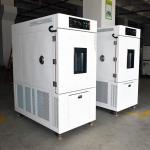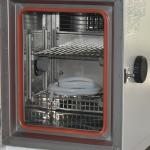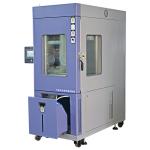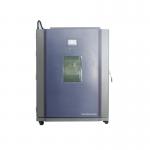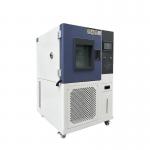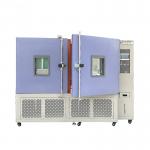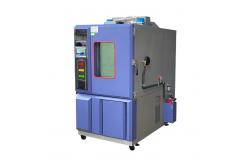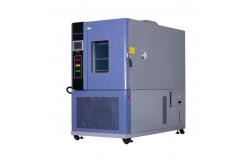In the highly competitive and fast-evolving world of consumer
electronics, ensuring the durability and reliability of devices is
of utmost importance. Temperature Humidity Test Chambers have
emerged as a crucial tool for manufacturers and developers to
assess how their products will perform under various environmental
conditions. These Temperature Humidity Test Chambers are specifically designed
to subject consumer electronics devices, such as smartphones,
tablets, laptops, wearables, and audio equipment, to a wide range
of temperature and humidity levels. The primary purpose is to
evaluate the device's functionality, performance, and structural
integrity in different environmental scenarios that consumers may
encounter. By simulating conditions like extreme heat and cold,
high humidity, and rapid temperature and humidity changes,
manufacturers can identify potential weaknesses and make
improvements to enhance the overall quality and user experience. - Sturdy and Controlled Chamber Construction
- The chamber is built with durable materials that can withstand the
rigors of continuous testing. The exterior is made of
corrosion-resistant metal, providing protection against wear and
tear. The interior is crafted with a smooth, non-reactive surface
to prevent any damage or interference with the tested devices. The
insulation used in the chamber walls is highly efficient, ensuring
minimal heat transfer and excellent temperature and humidity
control.
- The door of the chamber is designed with a reliable sealing
mechanism. It features a heavy-duty hinge and a secure locking
system, allowing for easy access while maintaining an airtight
seal. The door also has a large viewing window, typically made of
tempered glass, which enables operators to monitor the devices
during testing without affecting the internal environment.
- Precision Temperature and Humidity Control Systems
- The temperature control system is highly advanced, capable of
maintaining a broad temperature range. It can be set to
temperatures as low as -20°C, replicating cold storage or winter
conditions, and can reach up to +60°C, simulating hot and humid
climates or the heat generated during device operation. The
temperature accuracy is within ±0.5°C, ensuring precise and
consistent testing. The system utilizes a combination of heating
and refrigeration elements, along with a sophisticated feedback
loop and temperature sensors strategically placed throughout the
chamber to ensure uniform temperature distribution.
- The humidity control system is equally precise. It can adjust the
relative humidity from 10% to 95% RH. The humidity control accuracy
is within ±3% RH. The chamber is equipped with a high-efficiency
humidifier and dehumidifier, which work in tandem to achieve rapid
and accurate humidity adjustments. The system also features a dew
point control function, which is crucial for testing applications
where condensation needs to be managed, such as in devices with
sensitive optical or electronic components.
- Advanced Instrumentation and Data Acquisition
- The chamber is outfitted with a suite of high-quality sensors.
Temperature sensors are distributed evenly within the chamber to
monitor any temperature gradients and ensure a homogeneous thermal
environment. Humidity sensors provide real-time data on the
relative humidity levels. These sensors are connected to a
state-of-the-art data acquisition system that records and stores
all the measured parameters. The data can be accessed and analyzed
in real-time or retrieved later for in-depth studies.
- The control panel of the chamber is user-friendly and intuitive. It
allows operators to easily set the desired temperature and humidity
levels, as well as program complex test sequences. The panel
displays all the relevant information, including current
temperature, humidity, and the status of the control systems. It
also has built-in alarms and safety features to alert operators in
case of any abnormal conditions or system failures.
- Temperature Range: As mentioned, the chamber can operate from -20°C to +60°C. This
range covers many of the environmental conditions that consumer
electronics devices may experience. For example, a smartphone left
in a car during a hot summer day may reach temperatures close to
+60°C, while a device used in cold outdoor environments may be
exposed to temperatures near -20°C.
- Humidity Range: The relative humidity can be adjusted from 10% to 95% RH. In
humid regions, devices like tablets and laptops may be exposed to
high humidity levels, which can affect their performance and
longevity. Low humidity conditions, on the other hand, can cause
issues such as static electricity and drying out of components.
- Uniformity and Stability: The temperature uniformity within the chamber is maintained
within ±1°C, ensuring that all parts of the tested device
experience a consistent thermal environment. The humidity
uniformity is within ±5% RH. The stability of both temperature and
humidity is excellent, with minimal fluctuations over time,
allowing for accurate and repeatable testing.
- Accurate Environmental Simulation for Consumer Electronics
- The main function of these chambers is to accurately simulate the
diverse environmental conditions that consumer electronics devices
face. By precisely controlling temperature and humidity,
manufacturers can evaluate how their products will behave in
different real-world situations. For example, testing a wearable
device's touchscreen responsiveness and battery life under high
humidity and elevated temperature conditions can help identify
potential issues and optimize the design.
- The ability to conduct cyclic temperature and humidity tests is
also a valuable function. This involves subjecting the devices to
repeated cycles of temperature and humidity changes, which can
uncover latent defects or weaknesses that may not be apparent under
static conditions. For instance, a laptop's motherboard may develop
cracks or solder joint failures after several cycles of extreme
temperature and humidity variation, and these chambers can detect
such issues early in the product development cycle.
- Enhanced Product Quality and User Satisfaction
- Through comprehensive testing in the chamber, manufacturers can
identify and address potential problems in their consumer
electronics devices. For example, if a smartphone's camera lens
fogs up under high humidity, the company can explore different lens
coatings or sealing methods to prevent this issue. By improving the
device's resistance to environmental stressors, manufacturers can
enhance the overall quality and reliability of their products,
leading to increased user satisfaction and fewer returns or
complaints.
- The test chambers also help in optimizing the device's packaging
and storage conditions. By determining the ideal temperature and
humidity levels for storage, manufacturers can ensure that the
products reach consumers in the best possible condition and
maintain their quality during transit and on store shelves.
- Compliance with Industry Standards and Regulations
- The consumer electronics industry is subject to various standards
and regulations regarding product quality and environmental
testing. These Temperature Humidity Test Chambers are a reliable
tool for ensuring compliance. For example, many consumer
electronics products need to meet certain temperature and humidity
performance requirements set by international standards
organizations. By using these chambers to conduct tests in
accordance with these standards, manufacturers can prove that their
products are safe and reliable, facilitating market access and
building consumer trust.
- Regulatory bodies rely on accurate test results obtained from such
chambers to enforce safety and quality regulations. It serves as a
means for inspectors to determine whether consumer electronics
products can withstand the environmental stresses they may
encounter during their normal use, thereby protecting consumers and
maintaining the integrity of the market.
- Stringent Manufacturing Process
- The Temperature Humidity Test Chambers for Consumer Electronics
Device Testing are manufactured under strict quality control
procedures. Each component, from the insulation panels to the
temperature and humidity control systems, is carefully sourced and
inspected for quality and performance. The assembly process is
carried out by highly trained technicians in a clean and controlled
environment, ensuring the proper alignment and functionality of all
parts.
- The calibration of the temperature and humidity sensors and control
systems is a critical and regular part of the manufacturing
process. It is performed using traceable reference standards to
guarantee the accuracy and reproducibility of the test results.
Rigorous quality audits and inspections are conducted at various
stages of production to maintain the highest level of product
quality.
- Quality Certification and Validation
Our chambers have obtained relevant quality certifications and have
been validated by independent consumer electronics testing
laboratories. They have been proven to provide accurate and
reliable test results, conforming to the relevant international and
national standards for consumer electronics. We also continuously
update and improve our product bas
|
